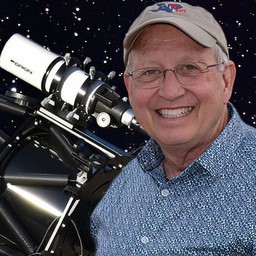

By Randall Light, MD
A comet is a ball of ice, rock, dust, and gas orbiting the sun in an elliptical orbit. Comets may have both a dust trail and an ion trail. Comets can range from very large and bright to small and dim. The nucleus is the central frozen part of the comet head. It is surrounded by the coma composed primarily of gas. The coma may have a green glow from the breakdown of di-carbon that is exposed to ultraviolet light from the sun. The dust trail is formed by debris breaking loose from the surface of the comet. The ion trail is composed of charged particles and points away from the sun (Figure 1). Although comets make an excellent photographic target, the resulting images can be quite challenging to process.

Figure 1
Planning comet photography is essential. When selecting photographic equipment and exposure setting, the size, location in the sky, brightness, and motion of the comet are all considered. The size of the comet is going to change as it approaches and recedes from earth. A planetarium program with current ephemeral elements for the comet can help determine the size of the comet at the time it is to be photographed. During the recent pass of Comet C/2022 E3, the comet size peaked at about four degrees. This is about eight moon diameters. This is an area much larger than can be seen with a large telescope. However, the head of the comet could be isolated and photographed with a telescope. More information about selecting equipment based on the field of view can be found in my article "Producing Images Based on Prevailing Conditions". A link to the article can be found in the references below.
The location of the comet in the sky will significantly influence the quality of the photos. The atmosphere is about half as thick at the zenith as it is at the horizon. Refraction is significantly increased below 30 degrees. Photographing a comet high in the sky is going to produce a better image than one taken near the horizon.

Figure 2
The way a comet moves in the sky is determined by its elliptical orbit and speed. It will appear to move more rapidly that the adjacent planets, stars, and deep sky objects. A sequence of images will easily demonstrate this movement. (Animated GIF Figure 2) This also means that making images with the shortest possible exposure time will reduce motion blur of the comet.
When photographing a comet, a decision is made whether to process a single image or make and combine multiple images. A single image is easier to process but may not have as much detail as one obtained by stacking multiple images. A single image may work well when the comet is being photographed with a terrestrial object of interest. Combining multiple images of a comet against a stellar background can reveal more detail about the structure of the comet but requires a more complex process to obtain an image of the comet and stars together without blurring either of them.
The following examples illustrate these concepts.
Figure 3 is a single image of Comet Neowise made at nautical twilight showing the comet, dust trail, and ion trail against a deep blue sky with stars and clouds. This was made with a Nikon D850, 50mm f/1.4 lens at f/2, and a 5 second exposure at ISO 800. This image was processed with Photoshop and the Topaz DeNoise AI plugin.
Figure 4 is a single image made at nautical twilight of Comet Neowise above the Regina Caelorum Observatory. The image was made with a Nikon D850, 50mm f/1.4 lens at f/3.2, and an 8 second exposure at ISO 800. The image was processed with Photoshop and the Topaz DeNoise AI plugin.

Figure 3

Figure 4
The following images were made from a group of six images made with a Nikon D850, a 600mm f/4 lens at f/5.6, and a 240 second exposure at ISO 1600. When multiple images of a comet are obtained and stacked, they can be aligned on the background stars or the comet. Aligning the images on the background stars produces streaking of the comet. (Figure 5)
If multiple images are aligned on the head of the comet, the stars are spread across the image. (Figure 6)

Figure 5

Figure 6
In the past various techniques have been used to subtract the stars from the comet image and process the stars and comet separately. A significant amount of work was required to clean up these images. Eventually they were then recombined to produce an image of the comet and undistorted stars. Around the time Comet C/2022 E3, the Green Comet, appeared new software was introduced that used artificial intelligence training to separate the comet from the stars in the background. The software was so good that many tutorials on comet processing were revised or removed from the internet. RC-Astro's StarXTerminator plugin for Photoshop and Pixinsight was the best of this new software in my opinion and produced very good results. An original image of Comet C/2022 E3 is shown in Figure 7.

Figure 7
The Green Comet image group was processed with the StarXTerminator plugin producing images of only stars that were then stacked (Figure 8) and a second set of comet only images that were also stacked (Figure 9). Each of these separated images was generated in PixInsight and finished in Photoshop as separate layers with a lighten blending mode. The Topaz DeNoise AI plugin was also used. The resulting image is shown in Figure 10. This image shows a rare anti-tail in front of the comet.

Figure 8

Figure 9
The resulting image is shown in Figure 10. This image shows a rare anti-tail in front of the comet.

Figure 10
Similarly, ten images of the head of the Green Comet were taken with a Nikon D850 and a ten inch f/8 RC telescope and a 120 second exposure at ISO 1600. Again, these images were processed with StarXTerminiator, PixInsight, and Photoshop resulting in the final image shown in Figure 11.

Figure 11
For an even greater challenge, a comet can be photographed with another deep sky or solar system object in the frame. On February 11, 2023, just before dawn, the Green Comet moved to within less than one degree of the planet Mars. A sequence of 10 images was obtain with a Nikon D850, a 300mm f/2.8 lens with a 1.7 teleconverter at 510mm, f/5.6, and 30 second exposures at ISO 1600. The StarXTerminator plugin was used to produce stars only and comet only images in PixInsight. The resulting images were stacked in PixInsight and finished in Photoshop using the Topaz DeNoise AI plugin to produce a final image of the comet, stars, and Mars (Figure 12).

Figure 12
In conclusion, comet photography is both challenging and rewarding. Planning based on the size, motion, brightness, and location in the sky of the comet aids in the selection of equipment including a camera and a lens or telescope with an appropriate field of view. Single wide field images, wide field images with foreground interest, images of a part of the comet, multiple comet images with a stellar background, and multiple comet images with additional celestial objects in the frame are all options. Newer software has significantly improved the processing of comet images.
Although Comet C/2022 E3, the Green Comet will not be back for 50,000 years, Comet C/2023 A3 is a recently discovered comet with an orbital period of about 80,000 years. If it survives a close encounter with the sun, it is expected to be visible at a magnitude of as much as 0.7 in October of 2024. In 2024 there will be a full solar eclipse and a bright comet. Get your cameras ready!

About the Author:
Randy is a retired medical neurologist who became a photographer in 1979 and an astrophotographer in 2013 when he retired. He has written articles, given talks, and received awards for his astrophotography.
Website: https://RandallLight.com

Spring 2023 Newsletter